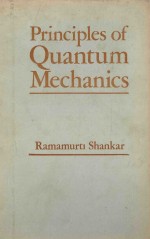

PRINCIPLES OF QUANTUM MECHANICSPDF电子书下载
- 电子书积分:18 积分如何计算积分?
- 作 者:RAMAMURTI SHANKAR
- 出 版 社:PLENUM PRESS
- 出版年份:1980
- ISBN:0306403978
- 页数:612 页
1. Mathematical Introduction 1
1.1. Linear Vector Spaces:Basics 1
1.2. Inner Product Spaces 7
1.3. The Dirac Notation 13
1.4. Subspaces 20
1.5. Linear Operators 21
1.6. Matrix Elements of Linear Operators 23
1.7. Active and Passive Transformations 32
1.8. The Eigenvalue Problem 33
1.9. Functions of Operators and Related Concepts 58
1.10. Generalization to Infinite Dimensions 61
2. Review of Classical Mechanics 79
2.1. The Principle of Least Action and Lagrangian Mechanics 79
2.2. The Electromagnetic Lagrangian 88
2.3. The Two-Body Problem 89
2.4. How Smart Is a Particle? 91
2.5. The Hamiltonian Formalism 91
2.6. The Electromagnetic Force in the Hamiltonian Scheme 95
2.7. Cyclic Coordinates,Poisson Brackets,and Canonical Transformations 96
2.8. Symmetries and Their Consequences 104
3. All Is Not Well with Classical Mechanics 111
3.1. Particles and Waves in Classical Physics 111
3.2. An Experiment with Waves and Particles(Classical) 112
3.3. The Double-Slit Experiment with Light 115
3.4. Matter Waves(de Broglie Waves) 117
3.5. Conclusions 118
4. The Postulates——A General Discussion 119
4.1. The Postulates 119
4.2. Discussion of Postulates Ⅰ-Ⅲ 121
4.3. The Schrodinger Equation 151
5. Simple Problems in One Dimension 159
5.1. The Free Particle 159
5.2. The Particle in a Box 165
5.3. The Continuity Equation for Probability 174
5.4. The Single-Step Potential:A Problem in Scattering 177
5.5. The Double-Slit Experiment 186
5.6. Some Theorems 186
6. The Classical Limit 189
7. The Harmonic Oscillator 195
7.1. Why Study the Harmonic Oscillator? 195
7.2. Review of the Classical Oscillator 199
7.3. Quantization of the Oscillator(Coordinate Basis) 199
7.4. The Oscillator in the Energy Basis 214
7.5. Passage from the Energy Basis to the X Basis 227
8. The Path Integral Formulation of Quantum Theory 233
8.1. The Path Integral Recipe 233
8.2. Analysis of the Recipe 234
8.3. An Approximation to U(t)for the Free Particle 235
8.4. Path Integral Evaluation of the Free-Particle Propagator 237
8.5. Equivalence to the Schrodinger Equation 240
8.6. Potentials of the form V= a+bx+cx2+dx+exx 242
9. The Heisenberg Uncertainty Relations 245
9.1. Introduction 245
9.2. Derivation of the Uncertainty Relations 245
9.3. The Minimum Uncertainty Packet 247
9.4. Applications of the Uncertainty Principle 249
9.5. The Energy-Time Uncertainty Relation 252
10. Systems with N Degrees of Freedom 255
10.1. N Particles in One Dimension 255
10.2. More Particles in More Dimensions 267
10.3. Identical Particles 268
11. Symmetries and Their Consequences 289
11.1. Overview 289
11.2. Translational Invariance in Quantum Theory 289
11.3. Time Translational Invariance 305
11.4. Parity Invariance 307
12. Rotational Invariance and Angular Momentum 313
12.1. Translations in Two Dimensions 313
12.2. Rotations in Two Dimensions 314
12.3. The Eigenvalue Problem of L2 321
12.4. Angular Momentum in Three Dimensions 326
12.5. The Eigenvalue Problem of L2 and Lz 330
12.6. Solution of Rotationally Invariant Problems 349
13. The Hydrogen Atom 363
13.1. The Eigenvalue Problem 363
13.2. The Degeneracy of the Hydrogen Spectrum 369
13.3. Numerical Estimates and Comparison with Experiment 371
13.4. Multielectron Atoms and the Periodic Table 379
14. Spin 383
14.1. Introduction 383
14.2. What is the Nature of Spin? 383
14.3. Kinematics of Spin 384
14.4. Spin Dynamics 396
14.5. Return of Orbital Degrees of Freedom 408
15. Addition of Angular Momenta 413
15.1. A Simple Example 413
15.2. The General Problem 418
15.3. Irreducible Tensor Operators 426
15.4. Explanation of Some “Accidental” Degeneracies 432
16. Variational and WKB Methods 439
16.1. The Variational Method 439
16.2. The Wentzel-Kramers-Brillouin Method 446
17. Time-Independent Perturbation Theory 459
17.1. The Formalism 459
17.2. Some Examples 462
17.3. Degenerate Perturbation Theory 473
18. Time-Dependent Perturbation Theory 481
18.1. The Problem 481
18.2. First-Order Perturbation Theory 482
18.3. Higher Orders in Perturbation Theory 492
18.4. A General Discussion of the Electromagnetic Interactions 501
18.5. Interaction of Atoms with Electromagnetic Radiation 508
19. Scattering Theory 533
19.1. Introduction 533
19.2. Recapitulation of One-Dimensional Scattering and Overview 534
19.3. The Born Approximation(Time-Dependent Description) 540
19.4. Born Again(Time-Independent Approximation) 545
19.5. The Partial Wave Expansion 556
19.6. Two-Particle Scattering 567
20. The Dirac Equation 575
20.1. The Free-Particle Dirac Equation 575
20.2. Electromagnetic Interaction of the Dirac Particle 578
20.3. More on Relativistic Quantum Mechanics 586
Appendix 593
A.1.Matrix Inversion 593
A.2.Gaussian Integrals 596
A.3.Complex Numbers 598
ANSWERS TO SELECTED EXERCISES 601
TABLE OF CONSTANTS 605
INDEX 607
- 《HTML5游戏开发进阶指南预售商品,预计09月25日到货》(印)香卡(Shankar,A·R·) 2013
- 《耶鲁大学开放课程 基础物理 力学、相对论和热力学》(美)R.Shankar著;刘兆龙,李军刚译 2017
- 《COMPUTER AIDED DESIGN IN MECHANICAL ENGINEERING》V RAMAMURTI 2222
- 《Arene-ruthenium complexes containing nitrogen and oxygen donor ligands》Sanjay Kumar Singh ; Daya Shankar Pandey 2013
- 《Modern instrumentation: methods and techniques》Ram Shankar ; Aryan Glootenberg 2013
- 《MECHANICS OF MACHINES THIRD EDITION》V.RAMAMURTI 2010
- 《LOCAL ANALYTIC GEOMETRY》SHREERAM SHANKAR ABHYANKAR 1964
- 《PRINCIPLES OF QUANTUM MECHANICS》RAMAMURTI SHANKAR 1980
- 《HANDBOOK OF MARKETING AND FINANCE》SHANKAR GANESAN 2012
- 《Quantum Field Theory and Condensed Matter An Introduction》R.Shankar 2017
- 《竞争战略 全译珍藏版》(美)迈克尔·波特(Michael E. Porter)著 2012
- 《网络互联技术手册 第2版》(美)(K.唐斯)Kevin Downes等著;包晓露等译 1999
- 《新版交换式以太网和快速型以太网 第2版》(美)(R.布雷耶)Robert Breyer,(美)(S.赖利)Sean Riley著;肖文贵等译 1997
- 《摄影100关键词》(英)克拉克著 2011
- 《守望百年 中英文对照爱情长诗》蔡丽双著;张智中译 2014
- 《环境政策概要》(英)卡罗琳·斯奈尔(Carolyn Snell)著;宋伟译 2017
- 《驼铃 中-英-波兰文对照诗集》蔡丽双著;张智中,(波兰)博古米娜·雅尼卡译 2015
- 《爱海情帆 中-英-罗马尼亚文对照爱情长诗》蔡丽双著;张智中,德拉戈斯·巴尔布译 2016
- 《准备,开始,哎哟》(美)弗兰·马努斯肯著;(美)黛安娜·帕尔米西若绘;魏亚西译 2014
- 《埋藏在后院》(美)盖尔·赫尔曼著;(美)杰里·斯马斯绘;筱舟译 2014
